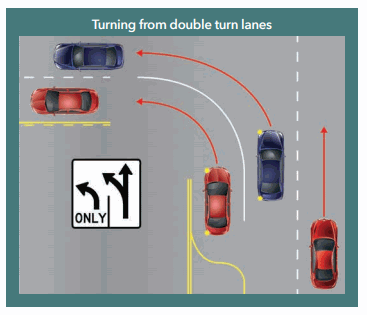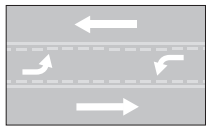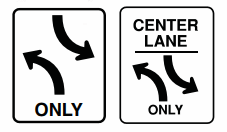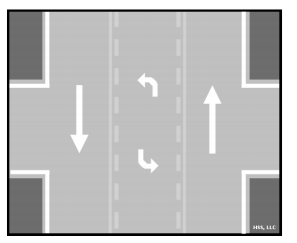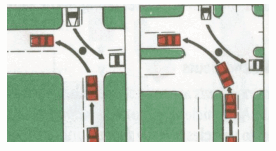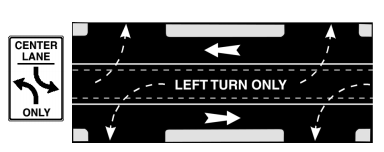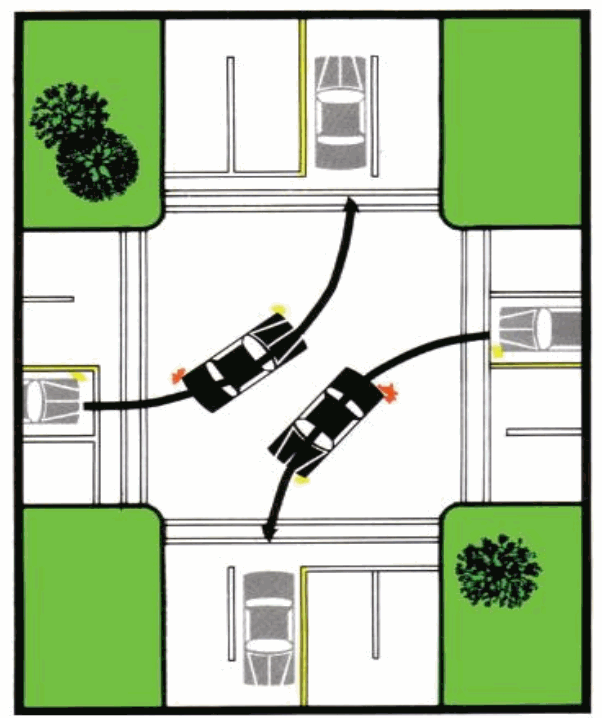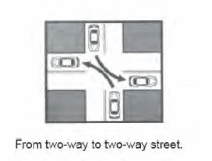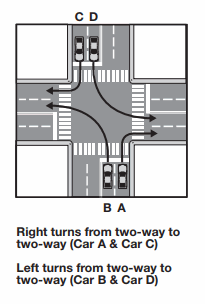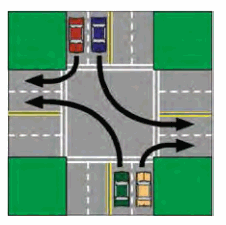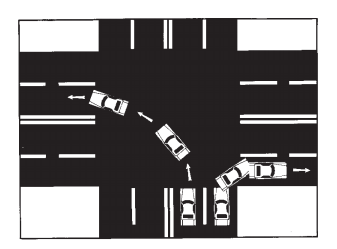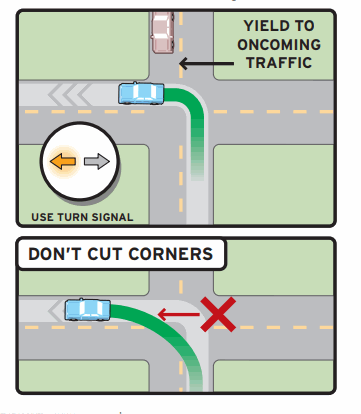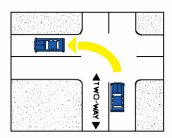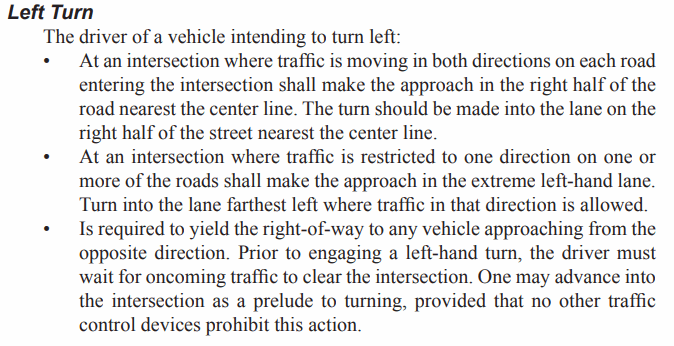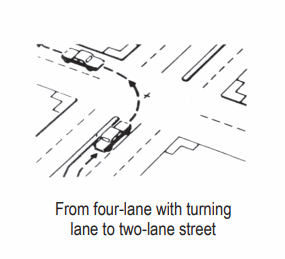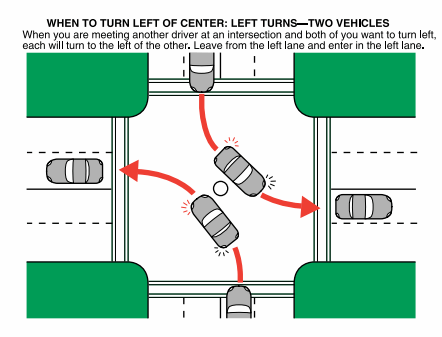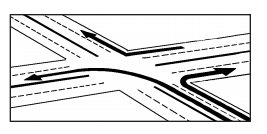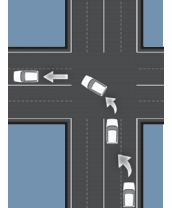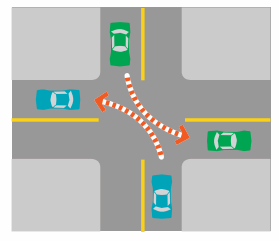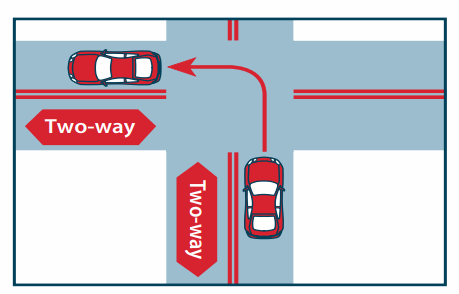Typically we write articles about saving money and other financial topics but today I would like to share some advice that could help prevent an accident.
The reason I am writing this is because I saw this Meme on Facebook today and several people were agreeing with it. What do you think?
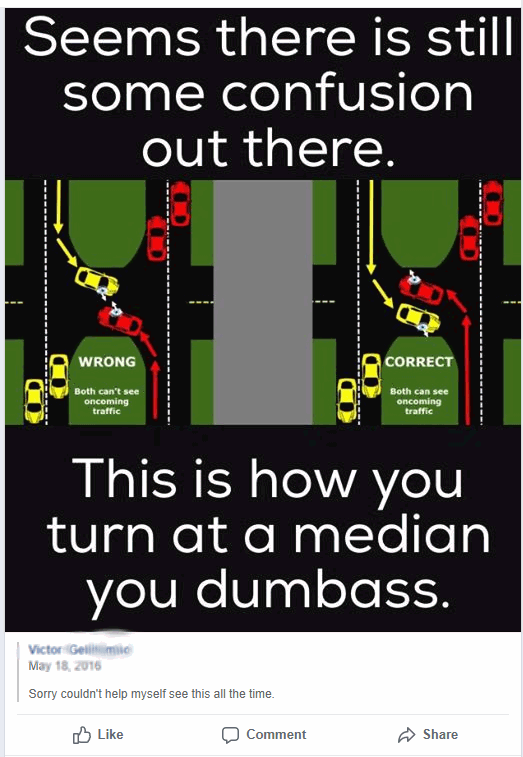
I am amazed at how many people agree with this meme and are happy to see that they were right all along. Except that in most states they aren’t. This was the way it was back when there was a lot less traffic on the roads but since then the law has changed in most states. Also, the one advantage they mention is actually false. The image is very misleading, if both cars in the left diagram pull ahead a bit (so they are in the same position as the right image) they can still both see around the back of the other car. But that isn’t the reason that the law was changed.
Doing it the way this meme suggests will cause more accidents. That’s why states changed it. Think about it for a minute: car 1 (yellow) approaches first and is sitting in the middle waiting. You arrive as the last car in a long line of traffic from the other direction (red cars) and instead of him being able to go you slow down and cut in front of him. He is looking (towards the right) at the open space behind you and you are now to his left and he impatiently slams into your rear quarter-panel.
Rhode Island says, One-sixth (1/6) of all crashes happen when one vehicle is turning left. Most of these would not happen if the driver made the turn properly.
Also what about situations where one side has heavy traffic and the other light (rush hour) if you cross to his right you can continue and be on your way. If you have to cut in front of him you might have to wait for him to get out of the way. And what if there is another red car already waiting now the second red car is blocking the yellow car. Much more crossing in front of each other causes accidents. This is the same reason traffic circles (roundabouts) reduce accidents and improve traffic flow.
But logic has nothing to do with it. What really matters is what the law says. If you do it wrong and cause an accident you will be liable, so let’s look at the various state laws. Many state’s laws are ambiguous or not clearly spelled out in their driving manual. Some states handle the issue with markings in intersections or staggered light changes.
Most states do not depict a U-turn but the left turn principle is the same.
Legal Left Turns in Every State
Alabama –
Alaska –
Arizona –
Arkansas –
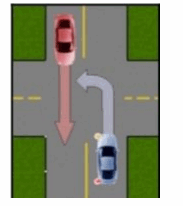
California –

“Left turn from a two-way street. Start the turn in the left lane closest to the middle of the street. Complete the turn, if safe, in either lane of the cross street (shown by the arrows). Use the center left turn lane if one is available. A left turn may be made from the other lane, if permitted by signs or arrows.”
Colorado –
Colorado doesn’t specifically say, it does give the following image for how to handle a center turning lane.
And it gives this regarding turning from a double turning lane. Obviously if you are in the left most lane you won’t be crossing over traffic coming from the opposite direction.
Regarding a U-turn it says:
U-turns: U-turns are forbidden unless they can be made without endangering other traffic. Prohibitory signs are usually posted at hazardous locations. U-turns are normally permitted where your vehicle can be seen for a great distance. However, it is always preferable to continue to the next street or turn-around area if a U-turn cannot be made safely. Do not try to make a sudden turn in front of traffic traveling either direction.
Connecticut –
Connecticut is another state with ambiguous instructions in their manual. It says “U-Turnsare not legal everywhere. So before you make a U-turn, check for signs prohibiting them. Never
make a U-turn on an expressway. When making a U-turn, give a left turn signal, stop, check for approaching traffic. Proceed into the outside or right hand lane traveling in the opposite direction.”
Shared Center Lane:
“These center lanes are reserved for making left turns (or U-turns when they are permitted), but can be used by vehicles traveling in both directions. On the pavement, left-turn arrows for traffic in one direction alternate with left-turn arrows for traffic coming from the other direction. These lanes are marked on each side by solid yellow and dashed yellow lines. In some areas, the shared center lane becomes a “reversible lane” during rush hours. Be sure you can enter the lane and that it is safe before you do so.”
Delaware –
Delaware appears to have the crossover issue it says: “Left turns – When making a left turn, avoid cutting the corner so sharply that you run into someone approaching from the left. However, be sure to leave room for oncoming vehicles to turn left in front of you.”
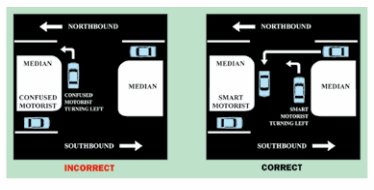
Florida –
 “Center Turn Lane. The center lane is shared for left turns in both directions of travel.”
“Center Turn Lane. The center lane is shared for left turns in both directions of travel.”
Florida provides many center turn lanes that are strictly designed to allow turning from one direction only thus eliminating the “crossover” issue. However, the manual doesn’t really address the cross-over issue.
Georgia –
The Georgia manual is also a bit obscure when in comes to the proper turning procedure.
“Turn Lanes- These lanes, bordered by solid yellow and/or broken yellow lines, is in the center of many streets and highways to make left turns. A motorist desiring to turn left should proceed to the turn lane just prior to making a left turn. Georgia law prohibits the use of this lane for any purpose other than making a left turn. You may enter this lane no more than 300 feet from the location of the left turn. When a turning lane is provided for vehicles traveling in both directions, you should use extreme caution before entering the turning lane to make a left turn. There may be a vehicle traveling in the opposite direction also entering the turning lane to make a left turn. This is especially problematic in congested areas.”
Hawaii –
Once again Hawaii is not terribly specific on the proper procedure. All they say is:
Get into the proper lane for a turn well in advance. Turn from the traffic lane nearest the direction of the turn and into the nearest traffic lane available. If you are not in the proper lane when you want to turn, continue on and make the turn elsewhere. Don’t force your way into the proper lane or make abrupt last
minute lane changes.
• Make precise turns; don’t swing wide or cut short.
• Slow to a proper speed before you enter a curve or begin a turn. Maintain a steady speed while in the curve or turn. Braking or an abrupt change of speed in a turn or curve can cause you to lose control of your vehicle.
• Avoid left and “U” turns whenever possible. These turns conflict more with other traffic, are much more hazardous than right turns and also impede other traffic.
Idaho –
• U-Turns: U-turns are not legal everywhere, so first look for prohibiting signs. When making a U-turn near a hill or curve, the law requires that you be able to see 500 feet in either direction. U-turns are prohibited in no-passing zones. Stop and yield to all traffic before completing a U-turn.
• Left Turns: Give your signal and approach the intersection in the lane closest to the left that is open to traffic going your direction. If you are on a two-lane road, you should move to the left side of your lane. Yield the right of way to pedestrians and oncoming vehicles. When safe, turn into the nearest lane in which traffic moves the direction you want to go. Do not cut the corner.
Illinois –
Illinois specifies: “Two-Way Left Turn Lanes- Either of these two signs can be used to indicate a two-way left turn lane in the center of a highway. Along with a sign, the two-way left turn lane is marked with yellow lines and white arrows.”
Indiana –

“Turning through an Intersection If you are facing a green arrow displayed with a red or green light, you have the right-of-way and may turn through an intersection, as long as the intersection is clear. If you are facing a green light displayed without an arrow, you may turn through an intersection as long as the intersection is clear. You must yield the right-of-way to all oncoming traffic. Only one vehicle at a time may move into an intersection to turn left.”
This indicates that there is no cross-over but instead only one car is allowed in the intersection at a time.
Iowa –
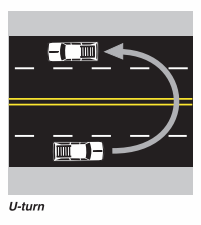
Kansas –
Kansas shows the following diagram which seems to indicate that crossing over is the correct method but the text says the other person will be turning “in front of your vehicle” which if you are still pointed forward means you aren’t crossing paths.
Shared Center Left Turn Lane- “On many streets where it is difficult to make a left turn safely, there is a shared left turn lane located in the middle of the roadway. The solid yellow centerline means you cannot use the center lane for passing. The broken yellow center lines show that vehicles traveling in either direction may use the center lane only to make left turns. When using a shared left turn lane do not move into the lane too soon. The longer you stay in the lane, the more likely you will meet someone coming in the opposite direction.
Watch for vehicles pulling out of entrances and side streets and do not use a shared left turn lane for anything but turning left. When using a shared center left turn lane you must check for vehicles ahead, check mirrors, signal left and check your left blind spot by looking over your shoulder. Steer smoothly into the shared center left turn lane and choose an appropriate gap in oncoming traffic to make the left turn.”
Left turns – “When making a left turn and the light turns green, pull into the intersection to be ready to turn. Avoid cutting the corner so sharply that your vehicle is in front of someone approaching from the left. However, be sure to leave room for oncoming vehicles to turn left in front of your vehicle. Always turn left from the left-most lane or when lane markings indicate multiple lanes can be used for a left turn at the same time.”
Kentucky –
Kentucky gives very little instruction regarding proper turning procedures. All it says is, “When turning into another street, turn into the lane nearest to you. If you are turning left from a street with two or more
lanes, turn from the lane nearest the center line. If you are turning right, turn from the lane nearest the curb. If you need to change to another lane, do so only after you have finished your turn and when the traffic is clear.
If you have already started through an intersection when the light changes, keep going. If you have started to make a turn, follow through. Last-second changes can cause collisions.
If you miss your turn, go on to the next intersection and work your way back to where you want to go.”
Louisiana –
Although not specifically spelled out this image would seem to indicate that you do not cross over in Louisiana.
Maine –
Maine clearly has a “no crossover policy” based on these images, showing left turns from both “two-way” and “divided” highways.
Maryland –
Not very much clarification. All it says is, “U-turns can be extremely dangerous and are not legal everywhere. If you must make a U-turn, first check to see if U-turns are allowed, and then turn on your left turn signal, stop and yield for approaching traffic. When the way is clear, proceed into the outside or right-hand lane traveling in the opposite direction.”
Massachusetts –
Massachusetts doesn’t provide a picture to clarify but says, “Do not swing your vehicle out of your lane when making a turn or swing wide through the intersection. Keep your vehicle centered in the middle of the lanes you are leaving and entering.”
“You may only make a U-turn from the lane closest to the center line.”
Left Turns from Center Lanes- “On some two-way roads, a center lane may be marked as a common left-turn lane to be used by vehicles in both directions. You may not travel in a center turning lane.”
Michigan –
“When multiple left-turn lanes are present, complete your turn by entering the lane that corresponds to your turn lane.” Probably indicating that you would not cross over but not clearly spelled out.
Minnesota –
Minnesota clearly spells out that you do not cross over.
Mississippi –
Mississippi has the largest and clearest depiction of a do not crossover left turn.
Missouri –
“If there are no signs or lane markings to control turning, you should turn from the lane that is closest to the direction you want to go, and turn into the lane closest to the one you came from.”
LEFT TURNS- “When making a left turn, avoid cutting the corner so sharply that you run into someone approaching from the left. However, you must leave room for oncoming vehicles to turn left in front of you.”
Although not 100% clear, this sounds like you do not cross over.
Montana –
Don’t cross over.
“Don’t cut corners. Don’t swing wide.”
Nebraska –
In Nebraska you do not cross over.
Nevada –
“Center lanes for left turns appear on many streets and roads. Most are marked on each side by solid yellow and broken yellow lines. You may cross these lines only to make a left turn onto or from the highway. These are not travel lanes and may not be used for passing. You may not travel more than 200 feet in a center turn lane before making a left-hand turn and you may not travel more than 50 feet in a center lane after making a left-hand turn onto the highway before merging with traffic.”
“When turning left, keep your wheels pointed straight ahead until you begin to actually complete the turn. on a two-way road, use the lane just to the right of the center line and complete the turn into the traffic lane closest to you going in your intended direction. Do not attempt to change lanes until you can do so safely.”
New Hampshire –
The safest way to turn is by crossing as few lanes of traffic as you can. Here are two rules to help you:
• Start from the lane closest to where you want to go. If you are turning left, start from the left lane. If you want to turn right, start from the right lane.
• Turn into the lane that is closest to the lane from which you came. On a left turn, turn into the left lane. On a right turn, turn into the right lane.
If you need to move into another lane, move only after you have finished your turn and the traffic is clear.
The image they provide does not specify whether you should cross over or not. But looks like probably not.
New Jersey –
According to the picture, it appears that New Jersey wants you to cross over. But…
Then they say:
“Left turns, two vehicles: When two vehicles meet at an intersection and both have signaled to turn left, extra caution must be applied. When safe, each motorist should turn to the left of the center of the intersection.”
If Both cars are “Left of the Center” they are NOT crossing over.
Left turn from a two-way road onto a two-way road: Approach the turn as close as possible to the line nearest to the center of the road. When turning, the vehicle should not cross lane markings. The motorist should keep to the right of the center line of the road that the vehicle is entering.
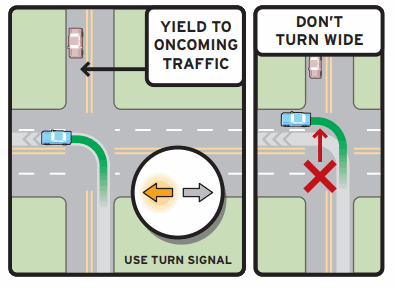
New Mexico –
Do not cross over.
“Left turns—When making a left turn, avoid cutting the corner so sharply that you run into someone
approaching from the left. However, be sure to leave room for oncoming vehicles to turn left in front of
you.
Multiple lanes turning—If there are signs or lane markings that allow for two or more turning lanes, stay
in your lane during the turn.”
New York –
Do not cross over.
“LEFT TURN FROM TWO-WAY ROAD INTO TWO-WAY ROAD: Approach the turn with your left wheels
as close as possible to the center line. Try to use the left side of the intersection to help make sure that you do not interfere with traffic headed toward you that wants to turn left. Keep to the right of the center line of the road you enter, but as close as possible to the center line. Be alert for traffic, heading toward you from the left and from the lane you are about to go across. Motorcycles headed toward you are hard to see and it is difficult to judge their speed and distance away. Drivers often fail to see a motorcycle headed toward them and hit it while they turn across a traffic lane.”
“You can make a U-turn only from the left part of the lane nearest to the centerline of the roadway, never from the right lane. Unless signs tell you otherwise, you can make a U-turn when you get permission to proceed by a green arrow left turn traffic signal, provided it is allowed and you yield to other traffic.”
North Carolina –
Does not specify.
North Dakota –
Doesn’t specify.
“When turning left from a two-way road onto a two-way road, begin as close to the centerline as possible and complete the turn as indicated in the picture.”
Ohio –
It appears that in Ohio only one car can enter the intersection at a time to turn left.
But the picture shows the car cutting short of the center mark.
Oklahoma –
Oregon –
Do not cross over.
“On a two-way road, approach the turn with your vehicle in the lane just to the right of the center line. Just before entering the intersection, look to the left, to the front, to the right and to the left again for oncoming traffic and cross traffic. Yield the right of way to oncoming traffic until it is safe to turn. Turn just before the imaginary center point in the intersection. Drive just to the right of the centerline of the street you are entering.”
Pennsylvania –
Unclear.
“On two-lane, two-way streets or highways, make left turns from as close to the centerline as possible. Make right turns from as close to the right edge of the roadway as possible. To turn left on multi-lane streets and highways, start from the left lane. If you are turning right, start from the right lane. If you are turning onto a highway, which has more than one (1) lane in the direction you wish to travel, turn into the closest lane going in that direction. Turn into the left lane when making a left turn, and turn into the right lane when making a right turn. If you want to change to another lane, wait until after you have safely completed your turn.”
Rhode Island –
One-sixth (1/6) of all crashes happen when one vehicle is turning left. Most of these would not happen if the driver made the turn properly. Studies have shown that a motorist’s greatest risk of a motor vehicle collision occurs at an intersection. Follow these steps to make a proper left turn:
1. Upon approaching an intersection at which you wish to make a left turn, you must give the proper signal in sufficient time to warn the driver of any vehicle behind you. As you gradually slow down, watch the mirror to see that the driver of the vehicle behind you has understood your signal. If the road is wide enough for you to do so without crossing the centerline, leave room for following vehicles to pass you on your right. Be sure that no vehicle behind you is trying to pass on your left, and, above all, never pull suddenly to your left from the right-hand lane. If you can’t work your way to the center early enough, go on to the next intersection.
2. As you approach the intersection, position yourself in lane position #2 far enough in advance before your
turn.
3. When you reach the intersection, wait until the way is clear. Do not turn your wheels in your intended path of travel until you are clear to make your turn.
4. Both the motor vehicle directly approaching you and the vehicle approaching on your right has the right-of-way.
5. When the road is clear, make your turn at the proper speed and keep to the right of the center of the
roadway. After turning into a four-lane road, keep driving in the center lane until you can change to the
right lane without getting in the way of other vehicles.
6. Always yield the right-of-way to pedestrians in the street.
7. Cancel your directional.
South Carolina –
“When you are meeting another driver at an intersection and both of you want to make a left turn onto the same street but going in opposite directions, then each should pass to the left of center of the intersection. It is illegal to make a left turn by keeping to the right of the center of the intersection, unless impractical to do otherwise or traffic control devices require a different path.”
South Dakota –
No picture. But probably do not cross over.
“Left turns- When making a left turn, avoid cutting the corner so sharply that you run into someone approaching from the left. However, be sure to leave room for oncoming vehicles to turn left in front of you.”
Tennessee –
Interestingly the Tennessee manual used the exact same image as Nevada.
“The first rule of turning is to turn from the closest lane in the direction you are traveling to the closest legal lane in the direction you want to go. The law says which lanes and positions you must use when turning, and the required signaling distances for such turns. This section expands on those rules and helps you learn proper procedures for signaling and making safe turns.”
Texas –
Doesn’t specify.
How to Make a Left Turn
1. Well ahead of the turning point, signal for a lane change. When it is safe, move into the center lane.
2. Use the left turn signal and slow down at least 100 feet from the corner.
3. Look in all directions before starting to turn. Stay to the right of the center line as you enter the intersection. Yield the right-ofway
to any vehicle approaching from the opposite direction.
4. To complete a left turn you should turn to the right of the center line of the road into which you are turning by entering the lane
in which you will interfere the least with other traffic.
5. Once you have completed your left turn, you may signal and change lanes if necessary
Utah –
Doesn’t specify but appears to imply that you don’t cross over.
Left turns:
- Signal left for two seconds;
- Yield to oncoming traffic; and
- Always turn left from the left side of your lane.
Vermont –
Unclear but probably do not cross over.
Left Turns – Many crashes take place when one motor vehicle is turning left. Most of these
collisions would not happen if the driver made the turn properly… Never move suddenly from the
right lane to the left lane… Position your vehicle within one foot of the centerline, if it is safe to do so…
When the road is clear, make your turn at the proper speed and keep to the right of the center line.
Lane use control signs, or pavement markings, may be used to direct drivers into the correct lane when turning. When driving from one road onto a multiple lane road where there is a choice of lanes, right turning drivers must turn into the right lane. Left turning drivers must first turn into the left lane. When there are two lanes turning in the same direction each turning lane must stay in their own turning path throughout the turn. Multiple lanes may turn in the same direction at the same time when lane use control signs or pavement markings permit it. Remain in the designated lane until after the turn has been completed. Lane changes may take place after the turn has been completed. Avoid changing lanes while turning.
Virginia –
Washington –
Do not cross over.
• Left turns – When making a left turn, avoid starting the turn so soon that you are turning on the wrong side of the street. However, be sure to leave room for oncoming vehicles to turn left in front of you.
West Virginia –
The picture looks like you wouldn’t cross over but the text doesn’t really specify. Sounds more like both people shouldn’t be in the intersection at the same time.
• “When turning left, watch for approaching traffic in the opposite lane. If traffic is about to reach the intersection at approximately the same time, stop until it is safe for you to turn.”
Wisconsin –
Don’t cross over.
“Keep just left of the midpoint of the intersection as you turn.”
Wyoming –
Unclear, all they say is “Turn into the proper lane (see turning diagrams).”
Conclusion:
Most States in the U.S. you do NOT cross over. But some states have unclear directions and Kansas and Delaware you are supposed to cross-over.





